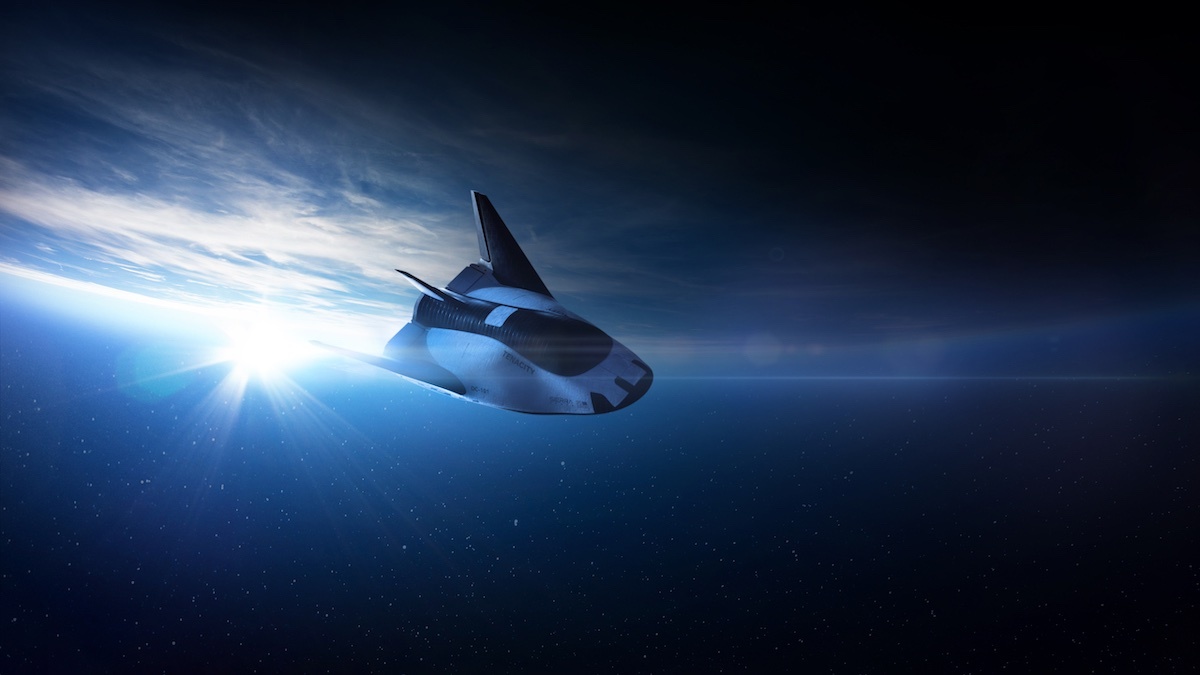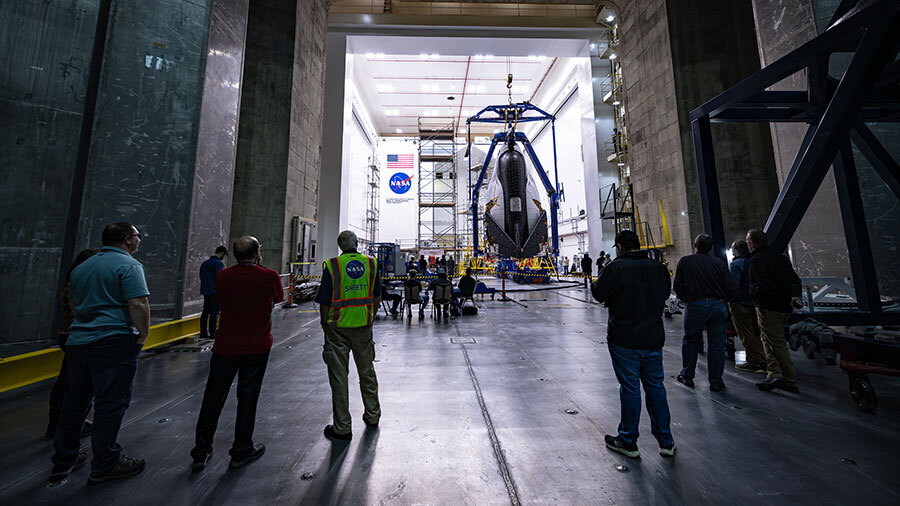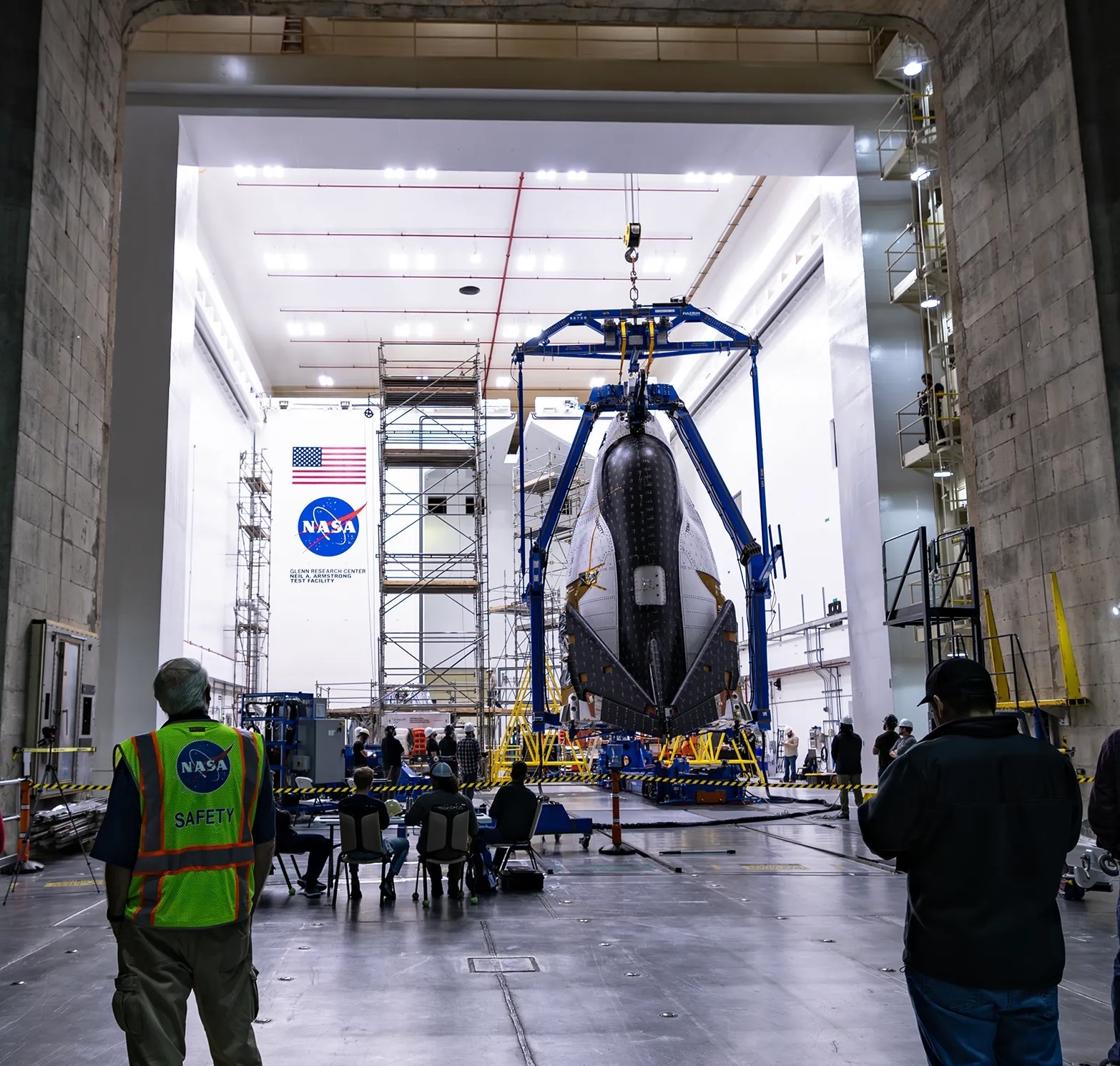17.12.2023

NASA and Sierra Space are making progress on the first flight of the company’s Dream Chaser spacecraft to the International Space Station. The uncrewed cargo spaceplane is planned to launch its demonstration mission in 2024 to the orbital complex as part of NASA’s commercial resupply services.
Dream Chaser and Shooting Star
The Dream Chaser cargo system, manufactured by Sierra Space in Louisville, Colorado, consists of two major elements: the Dream Chaser spacecraft and the Shooting Star cargo module. As a lifting body spacecraft, Dream Chaser is designed to be reused up to 15 times, and is modified from the HL-20 spacecraft developed at NASA’s Langley Research Center in Hampton, Virginia.
The spaceplane’s cargo module companion, Shooting Star, is designed to support delivery and disposal of pressurized and unpressurized cargo to and from the space station. The cargo module can be used only once and is disposed of prior to re-entry.
The Dream Chaser system will launch with its wings folded inside a five-meter fairing aboard a ULA (United Launch Alliance) Vulcan Centaur rocket from Space Launch Complex 41 at Cape Canaveral Space Force Station in Florida. The fairing panels will protect the spacecraft during ascent but are jettisoned once in orbit. Solar arrays mounted on the cargo module and wings of Dream Chaser are deployed during its autonomous rendezvous to the space station. In the event of a scrub, Dream Chaser is designed to be ready for launch in as little as 24 hours.
Mission Overview
During its first flight, Sierra Space will conduct in-orbit demonstrations to certify Dream Chaser for future missions. Teams at NASA’s Kennedy Space Center in Florida, NASA’s Johnson Space Center in Houston, and the Dream Chaser Mission Control Center in Louisville, Colorado, will monitor the flight. Sierra Space flight controllers will control the Dream Chaser spacecraft on the launch pad until the spacecraft is handed over to the Sierra Space ground operations team at NASA Kennedy following landing.
Far-field demonstrations will be conducted outside the vicinity of the space station before the spacecraft enters the approach ellipsoid, a 2.5-by-1.25-by-1.25-mile (4-by-2-by-2-kilometer) invisible boundary around the orbiting laboratory. These demonstrations will be required before Dream Chaser can enter joint operations with the NASA team at the Mission Control Center in Houston. These include demonstrating attitude control, translational maneuvers, and abort capabilities.
Near-field demonstrations, which must happen closer to the space station, include activating and using light detection and ranging (LIDAR) sensors, responding to commands sent from the space station, retreating from the station when commanded, and holding its approach, first at 1,083 feet (330 meters), then 820 feet (250 meters), and finally, at 98 feet (30 meters) from the station. Following successful completion of the demonstrations, Dream Chaser will move towards the space station.
As Dream Chaser approaches the orbiting laboratory, it will hold a final time approximately 38 feet (11.5 meters) from the space station, when a station crew member will use Canadarm2 robotic arm to grapple a fixture on the spacecraft’s cargo module before teams on the ground install the cargo module to an Earth-facing port on the Unity or Harmony module.
On its first flight to the International Space Station, Dream Chaser is scheduled to deliver over 7,800 pounds of cargo. On future missions, Dream Chaser is being designed to stay attached to the station for up to 75 days and deliver as much as 11,500 pounds of cargo. Cargo can be loaded onto the spacecraft as late as 24 hours prior to launch. Dream Chaser can return over 3,500 pounds of cargo and experiment samples to Earth, while over 8,700 pounds of trash can be disposed of during reentry using its cargo module.
Return to Earth
Dream Chaser will remain at the space station for about 45 days before it is uninstalled using Canadarm2. The spacecraft can land as quickly as 11 to 15 hours after departure, and there are daily opportunities if weather criteria are met. Landing weather criteria for Dream Chaser generally require crosswinds at less than 17.2 miles per hour (15 knots), headwinds under 23 mph (20 knots), and tailwinds below 11.5 mph (10 knots). Thunderstorms, lightning, and rain within a 20-mile radius of the runway or 10 miles along the approach path are not acceptable conditions for landing. Detailed flight rules will guide controllers in determining whether landing opportunities are favorable.
A combination of Dream Chaser’s 26 reaction control system thrusters will fire to commit the spacecraft to deorbit. Dream Chaser will re-enter Earth’s atmosphere and glide to a runway landing at Kennedy’s Launch and Landing Facility in the style of NASA’s space shuttle, becoming the first spacecraft to land at the facility since the final space shuttle flight in 2011.
Once Dream Chaser is powered down after landing, the Sierra Space ground operations team will transfer it to the Space System Processing Facility to perform necessary inspections, off-load remaining NASA cargo, and begin the process of preparing it for the next mission.
Sierra Space, formerly Sierra Nevada Corporation, was selected in 2016 as NASA’s third commercial cargo resupply spacecraft to service the International Space Station
Quelle: NASA
+++
Dream Chaser Undergoes Testing at NASA Test Facility in Ohio

NASA and Sierra Space are making progress on the first flight of the company’s Dream Chaser spacecraft to the International Space Station. The uncrewed cargo spaceplane is planned to launch its demonstration mission in 2024 to the orbital complex as part of NASA’s commercial resupply services. Credit: Sierra Space/Shay Saldana
NASA and Sierra Space are preparing for the first flight of the company’s Dream Chaser spacecraft to the International Space Station. Dream Chaser and its companion cargo module, called Shooting Star, arrived at NASA’s Neil Armstrong Test Facility in Sandusky, Ohio, for environmental testing, scheduled to start in mid-December, ahead of its first flight, scheduled for the first half of 2024.
The Neil Armstrong Test Facility, part of NASA’s Glenn Research Center in Cleveland, is home to multiple test facilities, including the Space Environments Complex and the In-Space Propulsion Facility, both stops for Dream Chaser. The complex is home to the Mechanical Vibration Facility, which subjects test articles to the rigorous conditions of launch.
While at Armstrong, the Dream Chaser winged spacecraft will be stacked atop its Shooting Star cargo module on the vibration table to experience vibrations like those during launch and re-entry to the Earth’s atmosphere.
Following vibration testing, Dream Chaser will be moved to the propulsion facility for thermal vacuum testing. Dream Chaser will be placed in a vacuum and exposed to low ambient pressures, low-background temperatures, and replicated dynamic solar heating, which simulates the environment the spacecraft will encounter during its mission. This facility is the only one capable of testing full-scale, upper stage rockets and rocket engines under simulated space conditions and conducting altitude hot fire.
After completion of testing at Armstrong, Dream Chaser will be shipped to NASA’s Kennedy Space Center in Florida for further launch preparations, currently scheduled for liftoff in the first half of 2024.
Quelle: NASA
+++
Der revolutionäre Dream Chaser® von Sierra Space geht in die letzte Testkampagne und das Raumflugzeug geht in den Orbitalbetrieb über
Flügel sind zurück
LOUISVILLE, Colorado – 15. Dezember 2023 – Sierra Space, ein führendes kommerzielles Raumfahrtunternehmen, das die erste End-to-End-Geschäfts- und Technologieplattform im Weltraum zum Nutzen des Lebens auf der Erde aufbaut, hat das erste Dream Chaser-Raumflugzeug ausgeliefert.Beharrlichkeit, zur Neil Armstrong Test Facility der NASA in Sandusky, Ohio.
Dream Chaser, das einzige kommerzielle Raumflugzeug der Welt, ist vor seinem Erstflug im Jahr 2024 in die letzte Testphase eingetreten. Die Testkampagne wird die Widerstandsfähigkeit des Raumfahrzeugs gegenüber den Herausforderungen des Starts und den anspruchsvollen Bedingungen im Weltraum bestätigen, während es sich auf seine erste Mission vorbereitet die Internationale Raumstation im Rahmen eines NASA-Mehrmissionsvertrags.

Dream Chaser schließt sich dem Frachtmodul von Sierra Space an,Shooting Star™, die im November in der NASA-Testanlage eintraf. Die beiden Fahrzeuge sollen in der Startkonfiguration gestapelt werden und ab dem Jahr strengen Umwelttests unterzogen werdenMechanische Vibrationsanlage. Bei dem Test werden sie den extremen Bedingungen der Startvibrationen auf dem leistungsstärksten Raumfahrzeug-Rütteltisch der Welt ausgesetzt.
Sierra Space setzt sich unermüdlich dafür ein, die größtmögliche Zuverlässigkeit seiner Spitzentechnologien zu gewährleisten. Dream Chaser, das zusammen mit dem bahnbrechenden Frachtmodul Shooting Star entwickelt wurde, wird den Raumtransport neu erfinden und die aufkeimende Ära der Raumfahrtkommerzialisierung einläuten, die als Orbital Age® bekannt ist.
„Bei Sierra Space leiten wir die nächste industrielle Revolution mit einer Geschäfts- und Technologieplattform ein, die unseren Kunden eine komplette, schlüsselfertige Lösung bietet, die Raumfahrt als Dienstleistung anbietet“, sagte Tom Vice, CEO von Sierra Space. „Zu unserer Plattform gehören Dream Chaser, ein revolutionäres, hochgradig wiederverwendbares kommerzielles Raumflugzeug mit globalem Start- und Landebahnzugang, und die erste betriebsbereite kommerzielle Raumstation, die die fortschrittlichste erweiterbare Strukturarchitektur nutzt, die die Kosten für die Produktentwicklung und -herstellung im Weltraum exponentiell senken wird. ”
Sierra Space revolutioniert den Weltraumtransport – die einzigartigen Fähigkeiten von Dream Chaser:
- Kein Sprung mehr ins Meer – Dream Chaser nutzt die weltweiten kommerziellen Start- und Landebahnen
- Entwickelt für hohe Wiederverwendbarkeit – mindestens 15 Missionen pro System
- Vollständig autonomer Betrieb
- Hochkapazitäts-Up-Mass- und Down-Mass-Nutzlasten (unter Druck und ohne Druck)
- Landungen mit niedrigem G – besser für Wissenschaft, Fracht und Besatzung
- Schneller Zugriff auf Nutzlasten und wissenschaftliche Erkenntnisse bei der Landung – einfache Integration in die Bodenlogistik
- Bahnbrechendes Antriebssystem auf Basis von grünem Wasserstoffperoxid
- Zweites Dream Chaser-Fahrzeug, Reverence, in Produktion
Ausgewählt durch einen NASA-Vertrag:
Dream Chaser wurde von der NASA im Rahmen des Commercial Resupply Services-2 (CRS-2)-Vertrags für den Frachtlieferungs-, Rückgabe- und Entsorgungsdienst für die Internationale Raumstation ausgewählt.
Hohe Wiederverwendbarkeit und Flexibilität:
Das hochgradig anpassbare Design von Dream Chaser macht es ideal für eine Reihe von Anwendungen und bietet schnelle Durchlaufzeiten, um verschiedene LEO-Anforderungen zu erfüllen. Die Flotte wird eine höhere Effizienz bei hoher Wiederverwendbarkeit bieten und den Beginn einer neuen Ära der Raumfahrtkommerzialisierung markieren. Die Raumflugzeugflotte mit mehreren Missionen ist für den Transport von Besatzung und Fracht in die erdnahe Umlaufbahn (LEO) konzipiert und kann sowohl für inländische als auch für internationale Kunden für globale Einsätze angepasst werden.
Neil Armstrong Test Facility der NASA:
NASAsNeil Armstrong-Testanlageist Teil des Glenn Research Center der NASA in Cleveland. Es befindet sich auf einer Fläche von 6.400 Hektar in Sandusky, Ohio und beherbergt einige der weltweit größten und leistungsfähigsten Weltraumsimulationstestanlagen, in denen Bodentests für die US-amerikanischen und internationalen Raumfahrt- und Luftfahrtgemeinschaften durchgeführt werden.
Über Sierra Space
Sierra Space ist ein führendes kommerzielles Raumfahrtunternehmen, das an der Spitze der Innovation und der Kommerzialisierung des Weltraums im Orbital Age® steht und eine durchgängige Geschäfts- und Technologieplattform im Weltraum zum Nutzen des Lebens auf der Erde aufbaut. Mit mehr als 30 Jahren und 500 Missionen Erfahrung in der Raumfahrt erfindet das Unternehmen sowohl den Raumtransport neu Traumfänger®, das einzige kommerzielle Raumflugzeug der Welt, und die Zukunft von Weltraumzielen mit der aufblasbaren und erweiterbaren Raumstationstechnologie des Unternehmens. Diese innovative „Softgoods“-Technologie ist hoch skalierbar und flexibel und wird eine neue Generation von Raumstationen definieren. Sierra Space baut und liefert außerdem eine Vielzahl von Systemen und Subsystemen in den Bereichen Solarenergie, Mechanik und Bewegungssteuerung, Umweltkontrolle, Lebenserhaltung, Antrieb und Wärmekontrolle und bietet unzählige Space-as-a-Service-Lösungen für die neue Weltraumwirtschaft.
Quelle: Sierra Space Corporation
----
Update: 26.01.2024
.
NASA, Sierra Space Invite Media to See Spaceplane for Cargo Missions

As part of NASA’s efforts to expand commercial resupply in low Earth orbit, media are invited to view Sierra Space’s uncrewed commercial spaceplane ahead of its first demonstration flight for the agency to the International Space Station in 2024.
The Dream Chaser event is scheduled to begin at 10:15 a.m. EST Thursday, Feb. 1, at NASA’s Neil Armstrong Test Facility in Sandusky, Ohio.
For the first time, the spaceplane is coupled with its companion Shooting Star cargo module in a 55-foot-tall vertical stack for environmental testing in the Mechanical Vibration Facility at Armstrong Test Facility’s Space Environments Complex.
During the event, the following officials will provide brief remarks about the agency’s efforts to enable commercial industry, the unique capabilities of the NASA test facility, as well as share more about Dream Chaser and its ongoing testing at NASA Glenn:
- Dr. Jimmy Kenyon, director, NASA’s Glenn Research Center in Cleveland
- Tom Vice, chief executive officer, Sierra Space
A question-and-answer session will follow remarks. Dr. Tom Marshburn, former NASA astronaut and chief medical officer for Sierra Space, also will be in attendance and available for interviews.
Media interested in attending must RSVP by 2 p.m. Wednesday, Jan. 31, to Brian Newbacher at brian.t.newbacher@nasa.gov or 216-433-5644.
Attendance is in-person only and limited to participants, invited guests, and credentialed media.
Dream Chaser and its cargo module are undergoing testing on NASA’s spacecraft shaker table, exposing the stack to vibrations like those it will experience during launch and re-entry to the Earth’s atmosphere. Armstrong Test Facility is part of NASA Glenn. Located on 6,400 acres, it is home to some of the world’s largest and most capable space simulation test facilities, where ground tests are conducted for the U.S. and international space and aeronautics communities.
In 2016, NASA awarded a Commercial Resupply Services-2 contract to Sierra Space to resupply the International Space Station with its Dream Chaser spaceplane and companion Shooting Star cargo module. NASA is opening access to space to more science by enabling commercial resupply missions to the International Space Station for the crew members aboard the microgravity laboratory. The agency is helping build a low Earth orbit economy where NASA is one of many customers of U.S. private industry for cargo, crew, and space destinations for the benefit of humanity. As NASA transitions low Earth orbit to industry, the agency also is returning to the Moon as part of Artemis in preparation for Mars.
Quelle: NASA
